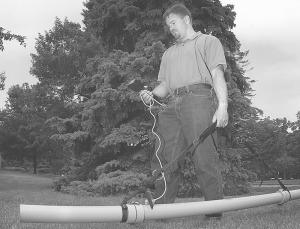2006 - Volume #30, Issue #6, Page #33
[ Sample Stories From This Issue | List of All Stories In This Issue | Print this story
| Read this issue]
Septic System Failure Finder Found
 |
Brad Lee, assistant professor, Agronomy, Purdue University, says "The sensor can help locate problems without digging. This is possible because soil contaminated with household waste has a higher electrical conductivity than the readings from the rest of the lawn. The instrument identifies these changes."
The instrument, called a non-invasive electromagnetic induction (EMI) sensor, consists of a hand held data reader connected to sensors in an 8-ft. long pipe. To gather data, the pipe is carried across and parallel to the surface of the area in question.
Previously the EMI sensor had been used to test for animal waste, salinity in fields and to locate storm sewers and buried landfills, not a great deal different from septic systems.
So far the sensor has been tested on septic contamination in fine-textured, glacial soils in northeastern Indiana. Lee says further studies are planned to verify if it will be effective in other soil types and environmental conditions.
If proven effective, the EMI sensor could be a handy tool for excavators. It is portable, collects data quickly and can measure through multiple soil layers. Lee says that maps prepared from sensor data can be used to assess building sites, plan future testing and locate the best sites for sampling and monitoring soils for possible septic contamination.
Contact: FARM SHOW Followup, Brad Lee, Agronomy Dept., Purdue University, 915 W. State St., West Lafayette, Ind. 47907 (ph 765 496-6884; bdlee@purdue.edu).

Click here to download page story appeared in.

Click here to read entire issue
To read the rest of this story, download this issue below or click here to register with your account number.




